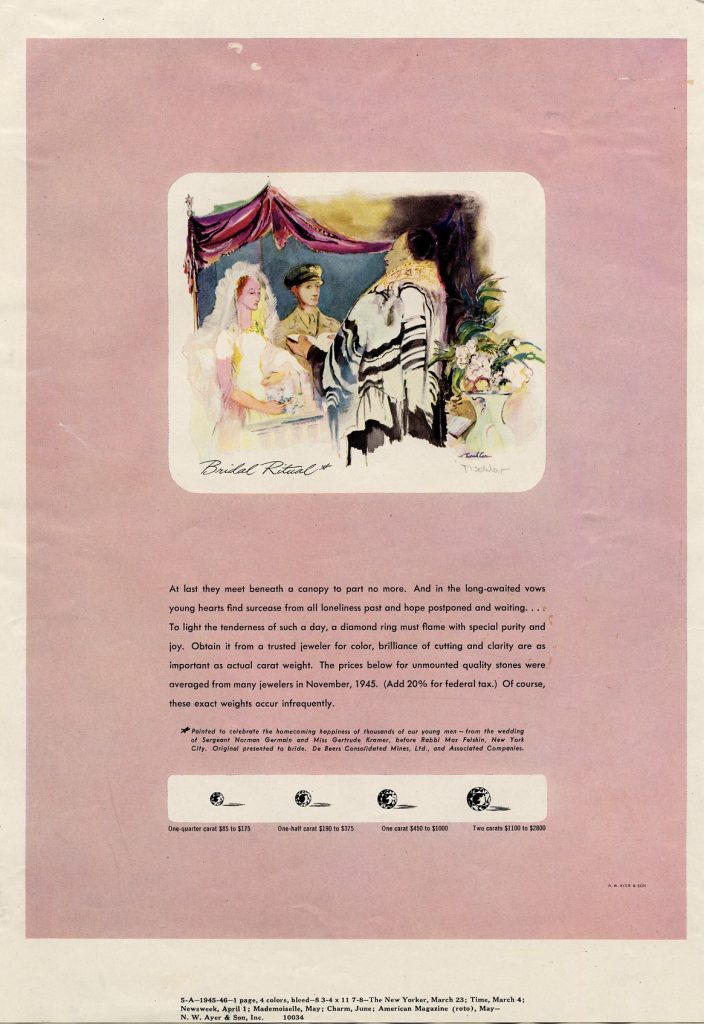Background
As men returned home from war, couples who were separated for years eagerly made up for lost time. More couples married in 1946 than in any other year in American history to date. One year later, the birthrate rapidly increased. This expansion of the American family was accompanied by economic growth. New families were eager to spend money and establish their post-war lives.
The emphasis on marriage in the post-war period reinforced ideals that existed long before the war. The nuclear family was the heart of American society. The ultimate goal for a young woman was marriage and motherhood. Although many women survived—and thrived—during the war years without a male breadwinner at home, they were not expected to do so any longer.
The increase in marriages also gave rise to the modern-day wedding industry. The post-war economy was fueled by a growing consumer culture that allowed Americans to buy products that supported their new post-war lives. Companies capitalized on this culture by producing and advertising for a range of wedding-related goods, including engagement rings, wedding dresses, decorations, and cakes.
About the Image
This is a 1945 advertisement for diamonds sold by the De Beers Company. It includes an image painted in honor of all the soldiers who married when they returned home. The painter specifically depicted the wedding of Norman Germain and Gertrude Kramer in New York City.
This advertisement appeared in several magazines, including The New Yorker, Time, Newsweek, and Mademoiselle.
Vocabulary
- De Beers: The name of a diamond-selling company.
- carat: A unit of weight for a precious stone.
- jeweler: Someone who sells jewelry.
- nuclear family: A family consisting of a father, a mother, and their children.
- rabbi: A leader or teacher in the Jewish religion.
- surcease: A peaceful ending.
- wedding industry: A term used to describe businesses that sell goods and services related to weddings.
Discussion Questions
- What product is this advertisement selling? What ideals is it selling? How does this relate to weddings?
- How does the text relate to the end of the war? How does it specifically highlight couples reuniting at war’s end?
- What is happening in the image? Who is depicted and what are they doing?
- What is the groom wearing? Why is this significant?
- Read the small note under the main text. What do you learn about the image? Why do you think the company chose to represent a real couple in their advertisement?
- What does this advertisement tell you about the business side of weddings? How are weddings good for the economy?
- This advertisement appeared in several magazines, including Mademoiselle. Why is it noteworthy that this ad appeared in a women’s magazine?
Suggested Activities
- APUSH Connection: 7.14: Postwar Diplomacy
- Study how printed advertising changed from the early to the mid-twentieth century. Combine this advertisement with the ad for electric home appliances and the ads during the Great Depression.
- Compare this ad to the recruitment poster “Longing Won’t Bring Him Back Sooner. . .” How does each speak to the challenges men and women faced in maintaining romantic relationships in wartime?
- Connect this resource to the report about women workers in the post-war era and the Wisconsin Legislature’s reflection on married women and work. How do these pieces speak to public opinion about marriage and women’s roles in post-war American society?
Themes
DOMESTICITY AND FAMILY







